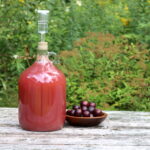Muscadine Wine (& Mead)
Muscadine wine is known to be a lovely, sweet wine to be sipped on during the summer or fall. It can be enjoyed as a dessert wine or made drier with stronger yeast strains. Use honey instead to make a sweet muscadine mead.
Servings: 20 glasses, Makes 1 gallon (about 4 Bottles)
Equipment
- Air Lock & Stopper
Ingredients
- 4 to 4-½ lbs muscadines destemmed
- 2-½ pounds Sugar about 2 cups per pound
- 1 tsp yeast nutrient
- ½ tsp acid blend
- ½ tsp Pectic Enzyme
- 1 packet wine yeast see note
- Water to fill
- Optional ~ Campden Tablet and Potassium Sorbate for Stabilizing I do not use these
Instructions
- Begin by crushing the destemmed muscadines by hand.
- Move crushed muscadines to a wide-mouth carboy.
- Heat a few quarts of water and add 1 cup of sugar. Stir until dissolved.
- Once cool, add to carboy.
- Add the acid blend, pectic enzyme and yeast nutrient next. The wine yeast should be added last.
- Rehydrate yeast in some room temperature water for 10 minutes before adding.
- Add yeast and top with water to leave 2 inches of headspace.
- Seal with a water lock and ferment in primary for 5 to 7 days.
- Siphon to a clean carboy, straining out the grapes and leaving the sediment behind. Add the remaining 2 cups of sugar at this point (do so by dissolving sugar in water before adding).
- Add enough water to bring the level up to the neck of the carboy and seal with a water lock.
- Ferment in secondary for at least 6 weeks. (Time spent in secondary will be longer for mead.)
- At the end of secondary, sample wine and adjust if needed. (See notes for info on backsweetening.)
- Bottle the wine and seal it with wine corks
- Allow to age at least 1 month before drinking and 6 months for best results.
Notes
Muscadine Mead
To make muscadine mead (or muscadine pyment) you will need about 3 lbs (1 quart) of honey to make a one-gallon batch. The time spent in secondary will be longer than for sugar-based muscadine wine, as honey takes longer for the yeast to digest than sugar. Recommended time spent in secondary for mead is 2 to 6 months.Yeast
For muscadine wine, there are a lot of yeast options available to you. I recommend looking for a wine yeast with moderate alcohol tolerance. Some good yeast choices include Red Star Pasteur Blanc, Lalvin EC-1118 and Lalvin K1-V1116 (especially for scuppernong grapes). See notes within the article for the specific qualities of each yeast.Stabilizing and Back Sweetening
If the wine tastes somewhat too dry at the end of secondary, backsweetening can counteract this. Rack to a clean container first to avoid stirring up any sediment. Next, stabilize the wine by adding 1 Campden tablet and ½ teaspoon potassium sorbate. Wait 24 to 48 hours to ensure the yeast has died off before adding any sugar. Sugar should be added in the form of a simple syrup made from equal parts water and sugar. Tastes will vary, but ½ cup sugar is a good place to begin. Once added, put back into ferment for a week before bottling to ensure fermentation does not restart. For more info on backsweetening and stabilizing, see notes within the article.Nutrition
Calories: 276kcal | Carbohydrates: 71g | Protein: 1g | Fat: 1g | Sodium: 2mg | Potassium: 208mg | Fiber: 4g | Sugar: 57g | Vitamin A: 68IU | Vitamin C: 0.05mg | Calcium: 38mg | Iron: 0.3mg
